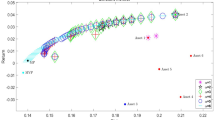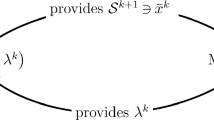Abstract
In this paper, we aim to find sparse solutions of the linear complementarity problems (LCPs), which has many applications such as bimatrix games and portfolio selection. Mathematically, the underlying model is NP-hard in general. Thus, an \(\ell _{1/2}\) regularized projection minimization model is proposed for relaxation. A half thresholding projection (HTP) algorithm is then designed for this regularization model, and the convergence of HTP algorithm is studied. Numerical results demonstrate that the HTP algorithm can effectively solve this regularization model and output very sparse solutions of LCPs with high quality.
Similar content being viewed by others
References
Candès, E.J., Randall, P.A.: Highly robust error correction by convex programming. IEEE Trans. Inf. Theory 54, 2829–2840 (2006)
Candès, E.J., Recht, B.: Exact matrix completion via convex optimization. Found. of Comput. Math. 9, 717–772 (2008)
Candès, E.J., Romberg, J., Tao, T.: Stable signal recovery from incomplete and inaccurate measurements. Commun. Pure Appl. Math. 59, 1207–1223 (2006)
Cottle, R.W., Pang, J.S., Stone, R.E.: The Linear Complementarity Problem. Academic Press, Boston (1992)
Donoho, D.L.: Compressed sensing. IEEE Trans. Inf. Theory 52, 1289–1306 (2006)
Facchinei, F., Pang, J.S.: Finite-dimensional variational inequalities and complementarity problems. Springer Series in Operations Research, vols. I and II. Springer, New York (2003)
Ferris, M.C., Mangasarian, O.L., Pang, J.S.: Complementarity: Applications, Algorithms and Extensions. Kluwer Academic Publishers, Dordrecht (2001)
Fukushima, M., Pang, J.S.: Some feasibility issues in mathematical programs with equilibrium constraints. SIAM J. Optim. 8, 673–681 (1998)
Fukushima, M., Tseng, P.: An implementable active-set algorithm for computing a B-stationary point of a mathematical program with linear complementarity constraints. SIAM J. Optim. 12, 724–739 (2002)
Gao, J., Li, D.: Optimal cardinality constrained portfolio selection. Oper. Res. 61, 745–761 (2013)
Lin, G., Fukushima, M.: New reformulations for stochastic nonlinear complementarity problems. Optim. Methods Softw. 21, 551–564 (2006)
Luo, Z. Q., Pang, J. S., Ralph, D.: Mathematical programs with equilibrium constraints. Cambridge University Press, New York (1996)
Olshausen, B.A., Field, D.J.: Emergence of simple-cell receptive field properties by learning a sparse code for natural images. Nature 381, 607–609 (1996)
Peng, D., Xiu, N., Yu, J.: \(S_{1/2}\) Regularization methods and fixed point algorithms for affine rank minimization problems. http://www.optimization-online.org/DB_FILE/2013/01/3727
Shang, M., Zhang, C., Xiu, N.: Minimal zero norm solutions of linear complementarity problems. J. Optim. Theory Appl. 163, 795–814 (2014)
Tibshirani, R.: Regression shrinkage and selection via the lasso. J. R. Stat. Soc. 46, 431–439 (1996)
Toint, P.H.L.: Global convergence of a class of trust region methods for nonconvex minimization in Hilbert space. IMA J Numer. Anal. 8, 231–252 (1988)
Xie, J., He, S., Zhang, S.: Randomized portfolio selection with constraints. Pac. J. Optim. 4, 87–112 (2008)
Xu, Z., Chang, X., Xu, F., Zhang, H.: \(L_{1/2}\) regularization: a thresholding representation theory and a fast solver. IEEE Trans. Neural Netw. Learn. Syst. 23, 1013–1027 (2012)
Zheng, X., Sun, X., Li, D.: Improving the performance of MIQP solvers for quadratic programs with cardinality and minimum threshold constraints: a semidefinite program approach. http://www.optimization-online.org/DB_FILE/2010/11/2797
Acknowledgments
This research was supported by the National Natural Science Foundation of China (71271021,11001011,11431002), the Fundamental Research Funds for the Central Universities of China (2013JBZ005) and the Scientific Research Fund of Hebei Provincial Education Department (No. QN20132030)s. The authors are grateful to the referees for their valuable comments which improve the presentation of this paper.
Author information
Authors and Affiliations
Corresponding author
Rights and permissions
About this article
Cite this article
Shang, M., Zhang, C., Peng, D. et al. A half thresholding projection algorithm for sparse solutions of LCPs. Optim Lett 9, 1231–1245 (2015). https://doi.org/10.1007/s11590-014-0834-7
Received:
Accepted:
Published:
Issue Date:
DOI: https://doi.org/10.1007/s11590-014-0834-7




